DIY Electric Vehicle from Recycled Parts
Converting a car to electric drive using recycled and salvaged EV and hybrid components.
Converting a car to electric drive using recycled and salvaged EV and hybrid components.
To make the experience fit your profile, pick a username and tell us what interests you.
We found and based on your interests.
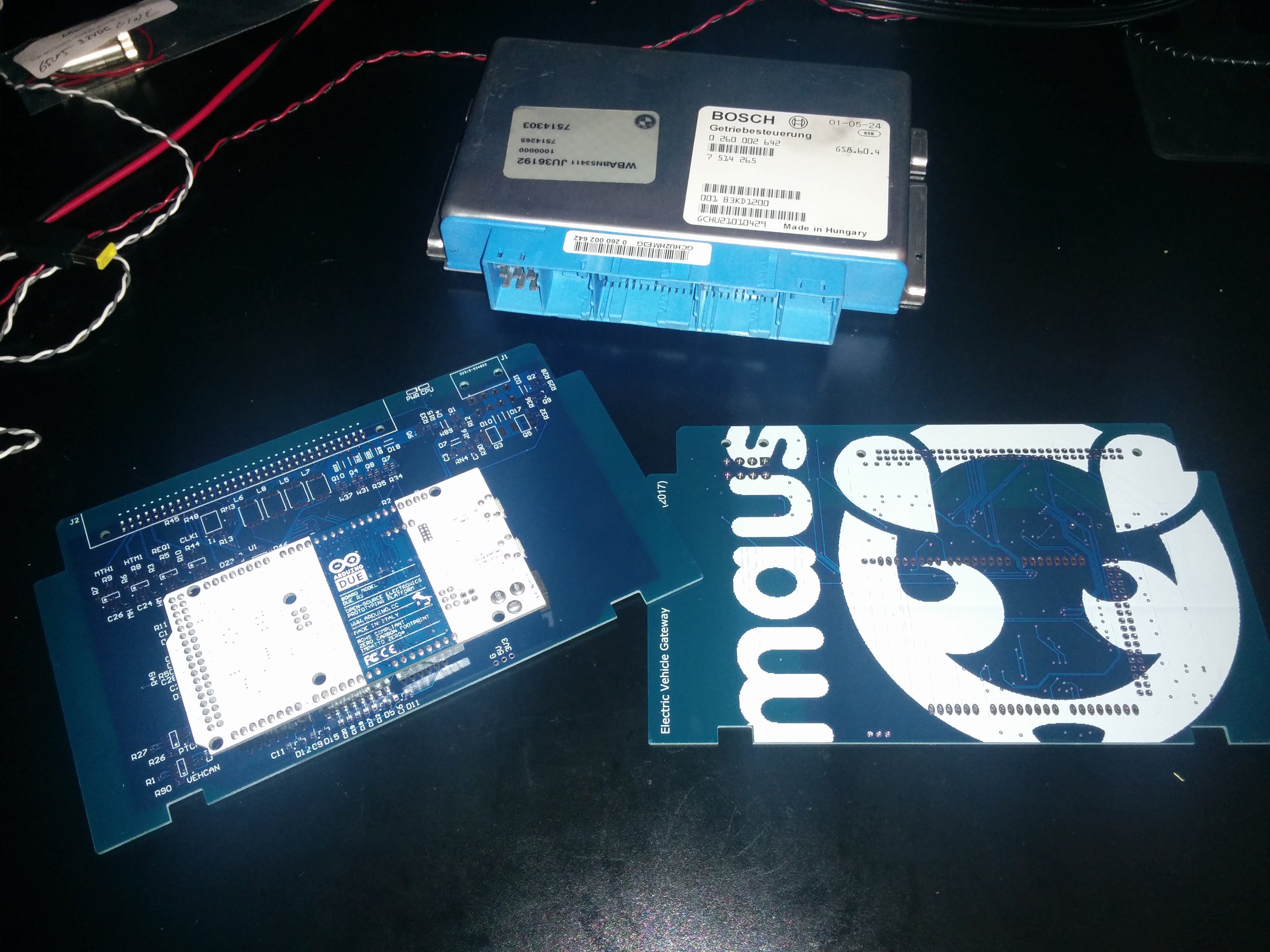
My last circuit board for my EV showed up! Just gotta populate, program, and wire it. Slides in to the slot the transmission ECU vacated.
I'll 3D print an enclosure for it, but the tabs sticking out the side will protrude since they act like "rails", same as the ECU it's replacing.
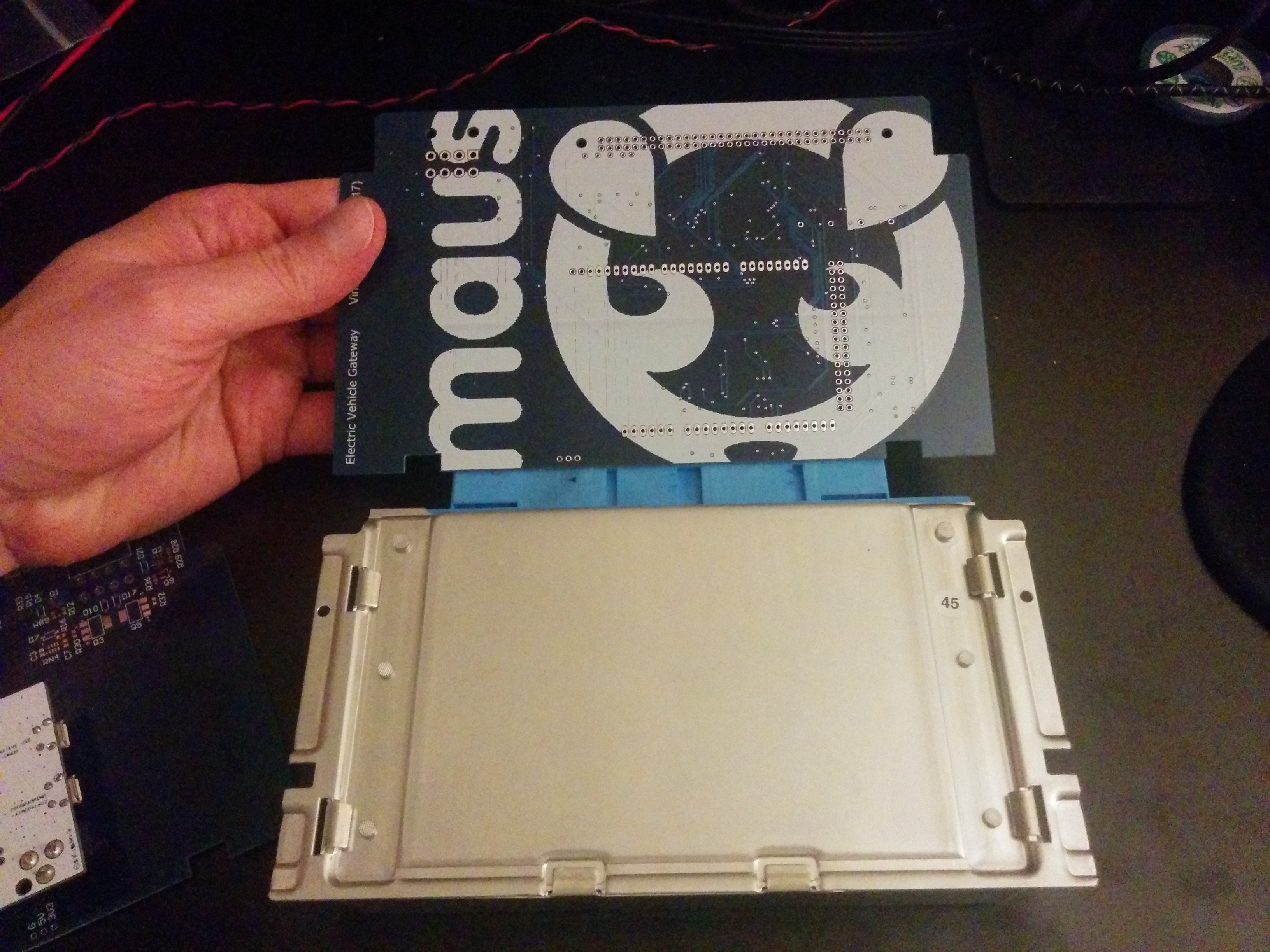
This is really the last piece to the puzzle to really unlock the full potential of this project. It will read the pedal position in a more reliable way that I am now, so drive will be smoother, and it will also control the transmission so I can use both gears. It will completely transform the driving experience!
Finally, it will read the key position so that I don't need to use a laptop to start and stop the car.
Got some business cards printed to hand out to people when showing off my project at shows and the like. QR codes on the front for my Hackaday build log and my LinkedIn. On the back, a list of components used in the car and the key performance figures.
I am not a graphic designer.

I spent some time over the past weekend making my project touch-safe. With my newly aquired 3D printer and some orange PLA, I modeled up a 3-piece insulator/housing for the high-voltage inlet to the inverter. This had previously been simply two copper posts with cables connected to them. Now those posts are housed in PLA, with some semblance of water proofing, and fully enclosed so that it can be shown off without worry of someone touching a live conductor.
Shown here is the full printed assembly, with copper installed. As well as the assembly steps. The base piece fits in to the oval shaped hole on the inverter, and is glued in to place with RTV.
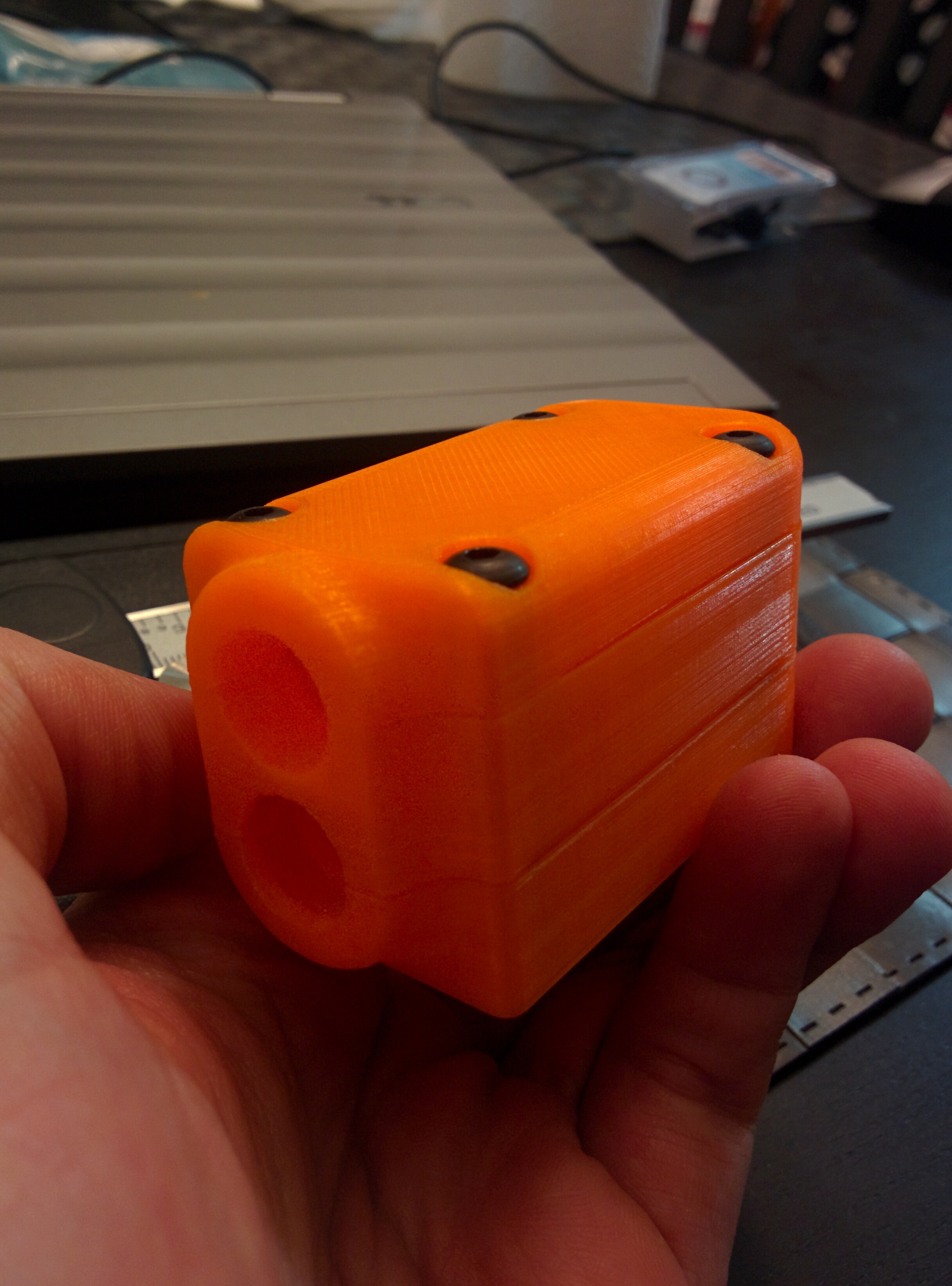


The first cable (+) connects to the shorter post, with O-ring around the sheath for sealing. There is sealing foam on both sides of the middle piece, which gets installed next.

The other cable (-) gets installed on the remaining post and the cap is installed.

4 screws are used to secure the stack together around the cables,
engaging with captive nuts on the bottom layer. I'm very pleased with
how it all goes together, even though it's not as water tight as I'd
hope due to some bending of the cable lugs during crimping.
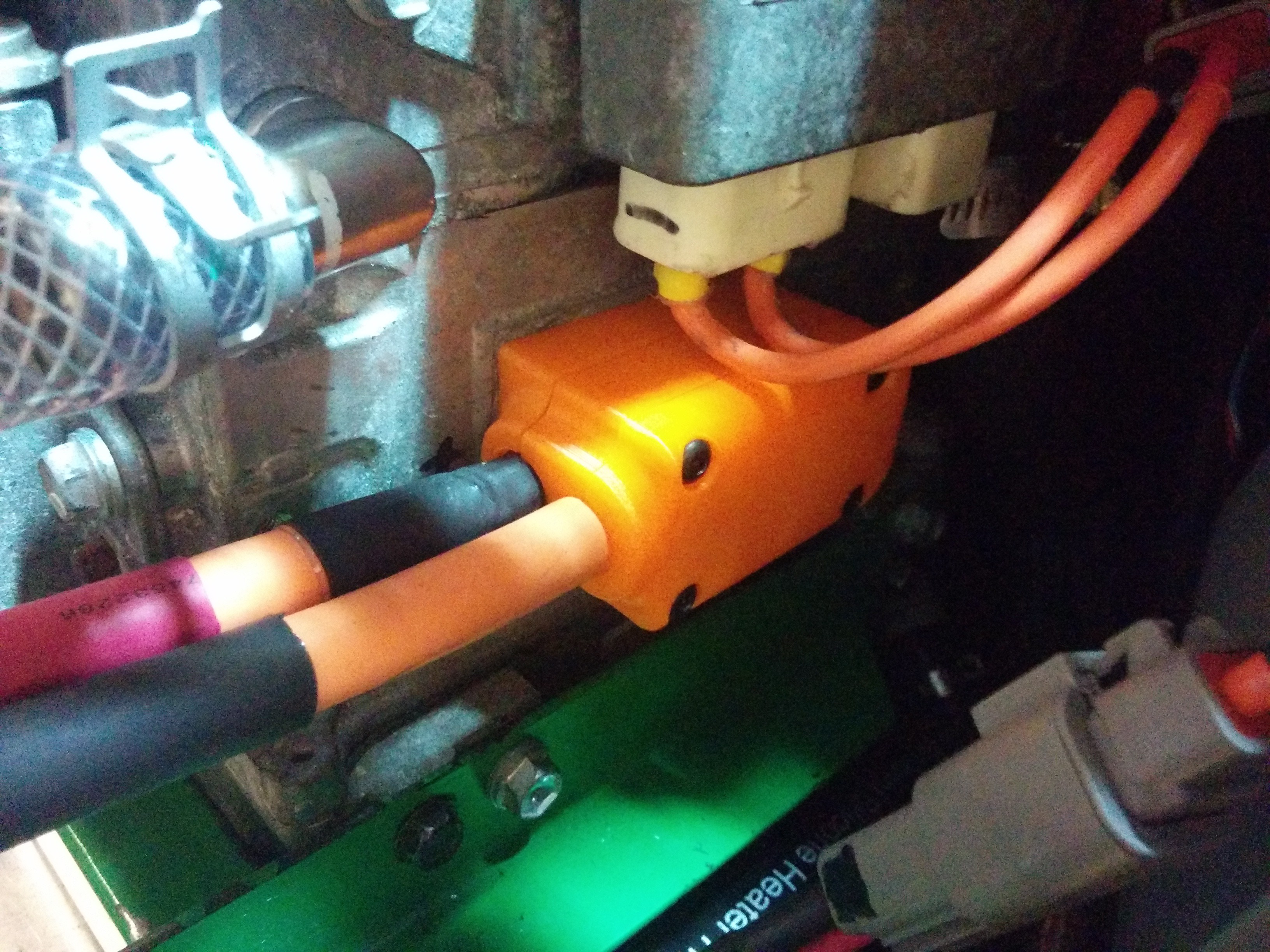
Sorted out the power limit on the Lexus inverter today. Two words: Holy Crap!
This thing has so much torque I can barely touch the pedal and spin the tires (well, the left one at least). I'm going to have to get an M3 rear end and some better tires very promptly.
It's just finishing touches at this point! So excited. I've never had a car that could do this before.
(sorry for the vertical video. Obviously I wasn't the one recording the video).
The car moved under its own power for the first time today! I still have some hacking to do on the Lexus inverter communications as it seems that I'm stuck in some sort of limp mode, but it's enough to move the car. Check out the video below:
The mechanical work is basically complete! I've been running in to trouble with the inverter. Reliable motor control is evading me, as is effective hardware protection. I've blown a few inverters at this point and am taking a step back to reconsider my plan for this final (and most important) piece of the puzzle.
Instead of continuing forward with my own control board, I've decided to try my hand at reverse engineering the communications between the stock inverter and the hybrid controller. I figure that the engineers at Lexus/Toyota, with all the resources and expertise at their disposal, will have tuned the motor control far better that I could ever hope to in my garage. The hardware protections would also be as designed so the risk of blowing an inverter should be much lower than with my amateur attempts at stable IPM motor control. The only way for this project to be reliable enough to act as my daily driver with the occasional thrashing is to leverage the effort already put in to the powertrain in Japan.
To that end, I spend last weekend with a borrowed 2007 Camry Hybrid. This car uses a very similar inverter (same control board inside, right down to the part number!), so I set up my Saleae logic analyzer and recorded the communication between the inverter and hybrid controller while performing a number of maneuvers and taking careful notes.
There is a LOT of data to sift through, but I've managed to isolate the pieces of data which contain the torque commands for each MG, as well as some parts which look like "modes" or "states". I will spend some more time this coming weekend with one of my spare inverters to see if I can manage to get the hardware to respond to these commands. Hopefully I can get away with feeding it the same data I recorded, only varying the torque commands, and have it respond.
I'm in to the details now. Lots of small things to get sorted out in preparation for the first drive. The down side is that there's a LOT of small things to do. The up side is that it really feels like I'm making good progress since I can get so many things done in a single day. The last two weekends have been extremely productive.
Here's a quick video of the charge port LEDs reacting to the plug being inserted. The light comes on when the door is opened to illuminate the port. Once plugged in, the light "breathes" with the color ranging from red to green depending on the state of charge.
The car is really coming together. I've managed to make enough torque to fight the parking brake and pull the hanging suspension back up in to the wheel wells. Getting some details wrapped up with hopes of moving the car under its own power next weekend.
All the components mounted and the cooling system plumbed up. The clear tube is there to be able to confirm flow through the inverter and other power electronics and verify that bleeding of air is complete.
This photo is before any tidying. The wiring is much more organized now, with well defined harnesses routed around the various components.
 I made a nice little panel for the top of the front battery. It holds the HV cables as well as the LV logic connections. It makes installing the cover for the front battery much easier than it used to be.
I made a nice little panel for the top of the front battery. It holds the HV cables as well as the LV logic connections. It makes installing the cover for the front battery much easier than it used to be.
Not going to say much here except that this is a huge milestone for this
project! The first wheel spin of an EV project is a special event. Very
excited to get this thing wrapped up and on the road! Not far now.
Got the BMS hardware mostly sorted out over the past couple days. All the wiring to the batteries and contactors is complete. Still have to sort out the wiring for the charge port (LEDs, Proximity, and Pilot).
With the BMS CAN wiring complete I was finally able to get the BMS talking to the entire pack at once. Here's a quick screen capture of some of the distilled data from the Volt battery OEM BMS modules.

For packs from two different cars and sitting for 8 months (I balanced them back in September), the voltage difference between the highest and lowest cell is very tight. I'm quite pleased!
I made a quick video showing the BMS controlling the contactors, including precharge and welded contactor detection.
Not much to see other than the voltage coming up. Most of the interesting stuff can be heard.
During the closing sequence, there are 5 clicks. They are (in order):
Battery negative contactor closing
Battery pack split contactor closing
Precharge relay closing
Battery positive contactor closing
Precharge relay opening.
During discharge, you can hear 3 clicks:
Battery positive contactor opening
(Delay while it waits for voltage to drop, showing it actually opened and isn't welded)
Battery negative contactor opening
Battery pack split contactor opening
The pack split contactor separates the rear battery pack from the front to keep voltages in the battery box at a lower level while sitting idle. When closed, it places both packs in series.
Once that was sorted out, I put the battery cover on and am ready to finish wiring in the inverter. That should take a handful of hours, after which I may be ready to do the first spin of the motors in the car and on the actual battery pack!
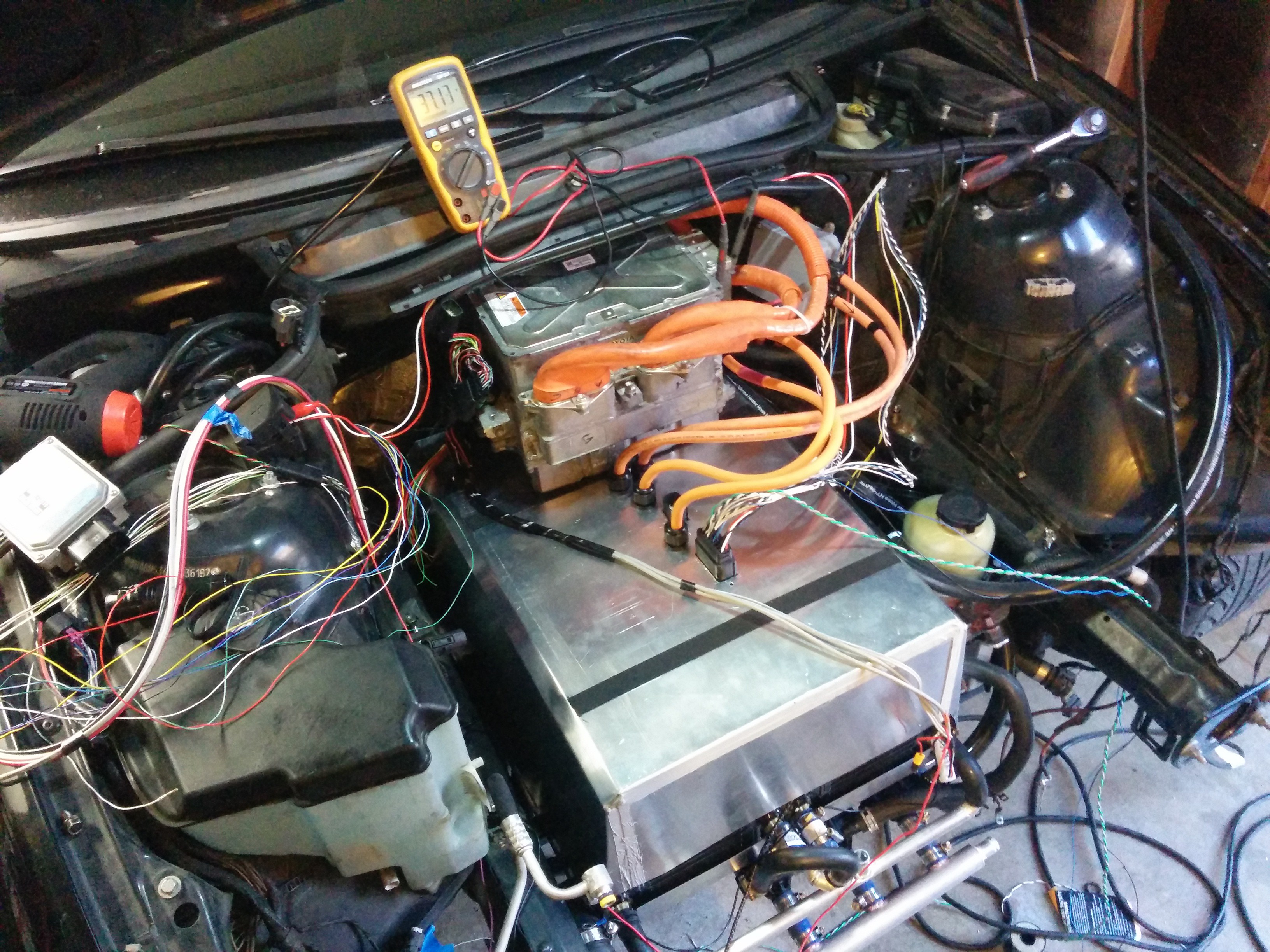
It's starting to feel like it's getting close now!
The mechanical fabrication is very close to being complete! So close in fact that the car came home with me this weekend (though on a trailer, not under it's own power). All that's left for the mechanical work is to finish the frame that straddles the front battery and to which the inverter, charger, DC-DC converter, and coolant heater mount to. And a return manifold for the coolant loops.
Look how dirty it is! The only clean spots are the door windows (since they were rolled down since October) and the trunk lid (since it was open that whole time). The car was in a garage the whole time. This is all dust that collected on it in there.

The brake vaccuum pump (from a Ford F150) is mounted in the empty cubby behind the front passenger side strut tower. The tank is an aluminum pipe with its ends capped. There's a GM manifold pressure sensor to monitor the vacuum level and help control the pump (same method I used on my previous EV conversion).
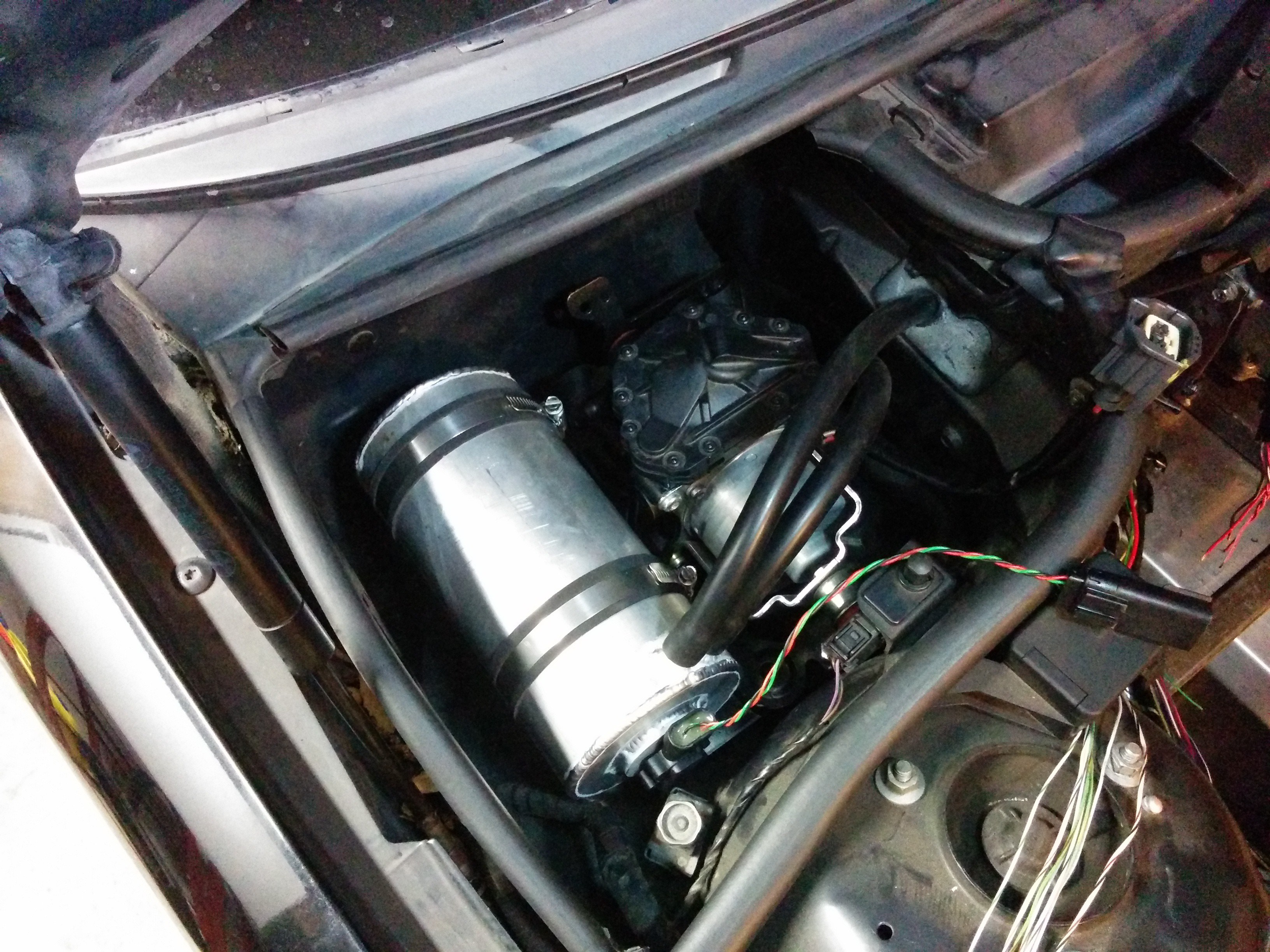
The front battery box cover is in place. I have to finish the wiring inside it and terminate it all in to the connectors on top. There are 4 glands for HV cables as well. Two coming from the rear battery, and two heading to the inverter. The charger will mount to the left in this photo, DC-DC and coolant heater will mount on the right (above the steering pump). The inverter is mounted to the frame already, so that's where it will live. The small box in the far left of the frame is the transmission oil pump controller. I need to shorten the wiring going to that and mount it somewhere with good airflow.
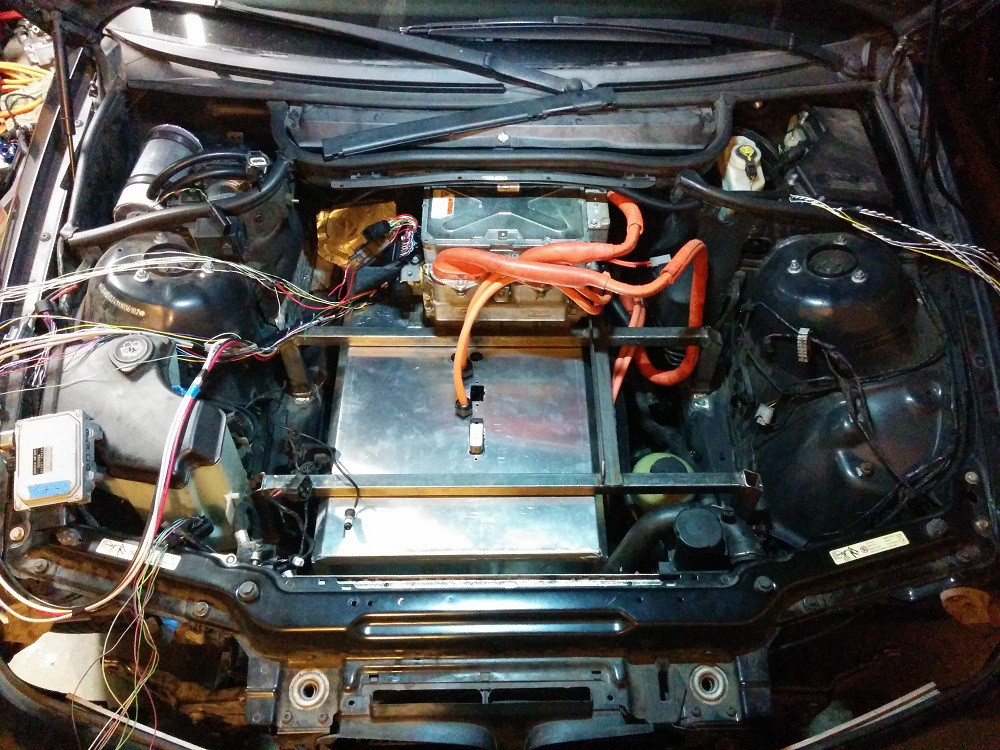
Create an account to leave a comment. Already have an account? Log In.
G'day! I have a little idea that haunts me for some time and i can't forget about it. I have my beloved hybrid crown 2009, very rare here in oz (with the same gear as a GS450h that you are using). Story short, but really don't want to lose on it by selling it and really thinking to take it with me overseas where only fully electric cars can be imported of this age. I wander if there's a way to replace that big clunky 2gr with say Warp11 or any other EV kit that is there on the market. Is it possible to replicate the start-stop controls that inverter tells over CAN-bus to the engine ecu, from what i understand. I read all your thread on DIYelectric and how you made your own board to talk to the inverter. The most relevant stuff so far i found on google patents here https://www.google.com/patents/US7350602. Just thought to ask if to even try to catch those can-bus messages or may be there's a better idea.
Regards,
Nick
hello , i have a question i am working on the same similiar project and what i have is two inverters one for a pruis 01 and also a 06 camry hybrid , i also have a motor of a toyota highlander 07 electric , and i was wondering how much would it cost for you to make any of those two work so i can put on my tacoma , i will handle shipping and what you would charge me my email is Montro3@yahoo.complease contact me back thank you
Go Mauswerkz! Love your project and great to see the car driving around for the first time!
i love the E46, owned several, can't wait to see your progress..
I've been following and loving this project. I think it is awesome that you are doing something so damned pragmatic, but in a nice attractive sedan package with decent performance. When do we get the next updates. Hopefully there are a few by now? :)
Cheers
Jo
That conversion is awesome, starting to collect parts, but for a diy Hybrid.
Doing a FWD with a rear Highlander traction motor, controller, and some battery packs do not know yet from what. Goal to have a Twincharge engine up front and a traction motor in the rear to get my 60ft time well below 1sec at the drag strip.
Ok for the controller did you use the Lexus controller or a after-market model like a Curtis controller?
If you used the Lexus controller how did you get it to work?
I've always wanted to do a hybrid! EVs just don't make good race cars. I'd want to be able to thrash it all day long.
I'm using the Lexus inverter with a custom control board. Struggling with the motor control code at the moment though.
Ok so I need the Toyota/Lexus inverter, I'm not knowledgeable on control boards yet, maybe I'll try a Curtis or other aftermarket controllors then.
Love the Project. any desire/interest in selling the boards when you have the details dialed in. I can do the fabrication and integration portion nicely to my project vehicle but have always struggled with the control and power electronics side! Im sure we could get a group buy going and have the boards made so you didnt have to do it! Also let me know if you need any contacts for fabrication As we have extensive composites and machining in house. Also have great overseas contacts to make cheap machined housings in bulk etc...
Lou
Also, are you able to toggle the rear gear set for speed/torque or is that hydraulically/speed controlled by the transmission? How did the motor tuning go? Are both motors in this transmission used for powering the vehicle or is the rear motor the only one that is powering and the front is not used in this configuration?
Hi Lou,
I'm leaning towards not selling the boards. They'll need a lot of work even after I'm done to make them something I'd be comfortable putting in other people's hands. More likely I'll open source the whole project.
Both motors in the transmission are used in this conversion. The rear motor (MG2) has a two speed gearbox on it that I also control from my inverter board directly via the solenoids. The hydraulic pressure comes from a transmission mounted pump and the stock Lexus pump controller (also controlled by the inverter board). The transmission will behave like an automatic once everything it programmed, but for the first drives, it will likely be held in a particular gear (either high or low) depending on driveability.
completely understood. count me in line for another beta tester! haha. I may run awd, and was considering using two of these setups or the highlander hybrid e-diff in front. is the inverter featured/robust enough to do something like that or did you not design with extra functionality in mind? If you have the design files and parts list handy I would gladly pay you for those items to get my conversion going...
greetings!
I'm curious how much you've dug into the CAN that the volt packs use. I was able to read out some numbers proportional to current, but I never tried telling it to balance.
http://nkirkby.scripts.mit.edu/nk/derptruck-and-the-struggle-for-ev-legitimacy/
I didn't touch the CAN outside of the battery. Only the internal CAN bus.
Hey! Cool project! I'm doing a really similar project and would love some input/suggestions. I'm using electric smart car parts to convert a 1974 Saab Sonett.
Nice! There's a guy on the diyEV forums doing a Sonnet with a drivetrain from a Nissan Leaf. Do you have access to the whole car, or just pieces from it?
I just have the motor/controller and charger. Still trying to get it to spin.
Where did you get the transmission (and the rest of the EV parts) and how much did it cost?
I'm especially interested in the economics of the battery packs...
All the parts came from a wrecking yard. Paid around $2k for each battery and about the same for the transmission. That's pretty standard these days for these parts.
love the E46, great project, can't wait to see some videos
This seems to indicate that the standard pack voltage in the lexus is 288v:
http://afvsafetytraining.com/erg/Lexus-GS450h-2013.pdf
And also that the motor in the transmission is a permanent magnet type motor. Which means that if you put too much current through the windings, you can demagnetize the magnets in the motor.
Although, astonishingly, that claims that the motor can do ~200HP.
Hi Andrew,
Yes, the original battery for the car in hybrid configuration was 288v. The inverter has a boost convert stage in it which boosts that voltage to 650v which is present on the inverter DC rails at the IGBTs. The battery and this converter are the bottleneck for EV mode on the original car. I'm tapping directly in the to 650v bus with my batteries, removing that bottleneck.
That's really interesting; I usually doubt these home-made EV projects at first, but I'm wrong to do that in this case, it looks like you're entirely savvy.
Now the questions are flying. That document rates the motor at ~150kW, but is the bottleneck you describe actually prevent it from ever being driven at 200A or thereabouts to achieve that? Maybe the 150kW rating is just for maximum regen mode?
I'm also wondering how that factor of 2x works out under regeneration, too, if there has to be a step-down converter, or if the regen amount is controlled to not put more than 288v back onto the battery bus.
The motor current is dependent on bus voltage and motor RPM. A quick arbitrary example: If the motor current limit is 200A and a 300v bus can maintain that current up to 4000rpm, then a 600v bus can maintain that current to 8000rpm. Ignoring efficiencies, torque is proportional to current and power is torque times angular velocity. The boost converter has a specific power rating (limited by DC bus current is power divided by bus voltage). In EV mode, as long as the power rating of the boost converter isn't exceeded, it doesn't care what the motor current is. So yes, you could get full motor current using the converter, but only until you hit the power rating of the converter.
During regen, in the original car, the converter switches to buck operating and regulates the current back to the battery. I won't have to worry about this since my battery will be on the IGBT bus.
Regarding demagnetization, I'm not going to be exceeding the original current capability of the motor, only the power capability. By putting the batteries directly on the HV bus, I'll be able to maintain full torque/full current to higher RPM that what was possible through the boost converter.
Become a member to follow this project and never miss any updates

 leadacid44
leadacid44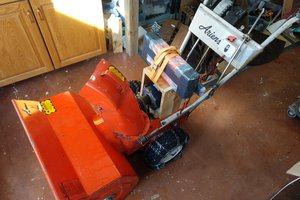
 Ryan
Ryan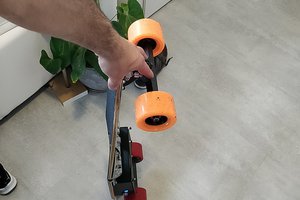
 Lucas
Lucas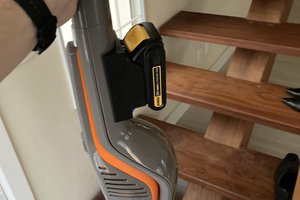
This project aims to create an exciting, environmentally friendly electric car by using a 2001 BMW 330ci coupe with high-performance hybrid motors. It focuses on sustainability by using salvaged or recycled components, keeping costs low while achieving a 110-mile range and respectable performance. An innovative approach to address EV criticisms!